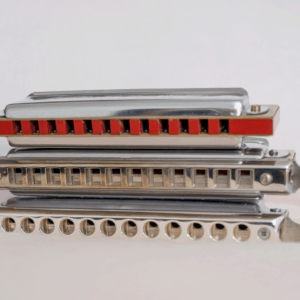
The harmonica is a feisty little instrument full of flavor. Popular as a beginner and gateway instrument, it’s also considered one of the friendliest instruments to learn. But how do you learn this instrument and is it easy? You may have heard some of your favorite musicians playing the harmonica and wondered about taking it up yourself. The harmonica is fairly easy to learn; in fact, just blowing into the diatonic harmonica will produce a major chord. Like any musical instrument or any skill, true mastery, however, will take many years.
If you’ve decided to take the leap into learning the harmonica, read on for more tips and advice.
How Long Does It Take To Progress On The Harmonica?
How long it takes you to learn the harmonica will depend on how much you’re willing to put into it. If you’ve got a strong desire burning inside of you to get to know this instrument then your journey will progress much quicker than if you’re only half enthused about the process.
How quickly you’re able to progress on the harmonica will be dictated by your past experiences too. If you have previous musical experience, this could help you grasp what’s going on sonically when you blow into a harmonica. This could be experience with other instruments or even music theory.
Things like how you learn, your approach to new skills, and your personal abilities will all dictate how easy it is for you to learn to play the harmonica. As with all musical endeavors, how good your ear is will have a big impact on how quickly you manage to learn the harmonica.
But setting aside all personal capacities, abilities, and past experiences, the singular most important facet that will affect how quickly you learn the harmonica is your personal attitude.
If you practice regularly you should be able to progress with the harmonica very quickly. In a few months, you should be able to play simple pop tunes.
In two weeks, you should easily be able to play this:
Two months should get you roughly up to this standard:
What Kind Of harmonica Player Do You Want To Be?
Knowing what kind of player you want to be will give you the roadmap you need. It’ll allow you to map the skills you need to develop, and the techniques you’ll want to work on. A good way to get clear with this is to focus on what it is that has drawn you to learn the harmonica in the first place.
It could be a player or musician who has inspired you, a particular song, group, or playing style. Getting in touch with what it is that attracted you to play in the first place can help you be clear about where you want to go on your journey with the harmonica. It can help you set out your roadmap. Once you know where you want to go and get clear with this, you can start to set realistic goals and benchmarks and begin to track your progress.
Start With Easier Genres
Start learning easier genres, like some popular or folk songs. In the US, the harmonica (or harp as it’s sometimes known) is mainly used in folk, folk-rock, blues, and country, as well as any hybrid crossovers between these styles. However, music is an art so you’re by no means limited to anything! But unless you’re somewhat of a musical genius, you’ll probably have to begin by playing music by other musicians, and choosing simple songs is a good place to begin to stop you from getting overwhelmed.
Create A Roadmap.
Firstly it’s good to know that you’ll be able to get a good sound out of a harmonica from day 1.
If your goal is to be able to play some simple pop or folk songs then you should easily be able to do this within a couple of months.
For playing some simple pop or folk songs, you’ll want to work on your note isolation skills to be able to play some simple melodies. This book is a good place to start dipping your toes into the world of harmonica melodies. Some songs may require playing a few chords, so you’ll want to focus on that aspect of your playing too.
Whilst exercises and drills are important for the student musician, they can be a bit stale. There’s nothing quite like learning techniques through playing songs you love.
However, if you’re more attracted to advanced techniques such as bending and playing the blues, then this will take you significantly more time to master. To play the blues, you’ll have to learn some basic theory and blues chord progressions. This book is a good place to start your journey with the blues harmonica.
Whatever style has drawn you to learn the harmonica, be clear about your goals. Writing them down is a good way to be clear with yourself what your intentions are. You could even make yourself a realistic timeline to keep you motivated and to ensure you’re on the right track. Estimate how much time you realistically will be able to devote to practicing, and then divide the vital techniques between this time.
Before you know it, you’ll be on your way to being a real harmonica pro!
Techniques To Master
Learn How To Breathe Properly And Relax.
Breathing should always be done from the diaphragm, which is located above your stomach and below your sternum. Breathing should always be from the diaphragm, yet few people are breathing from here nowadays.
Breathing properly will also help in regulating many functions of your body and mind. Pranayama is the ancient science of breathing hailing from India and will help calm your mind, regulate your nervous system and increase overall longevity. Learning the harmonica or any other wind instrument will help you connect with your breath and will literally improve your life!
Learning how to relax will do wonders for your playing too. Carrying tension anywhere in your body will affect your nervous system, which is intimately connected to your breathing. Learning how to breathe properly will also help tone your vagus nerve (the longest nerve in your body) which will help you achieve homeostasis. This will help in healing many imbalances in your system. Learning the harmonica (or any other wind instrument) is good for your health.
Building Up Stamina
First off you may find you need to build up strength in your lungs to play. At the beginning of your journey, you may find yourself feeling short of breath and light in the head. This is perfectly normal when beginning any instrument that requires your breath to produce a sound and nothing to worry about. You just have to train your body and build up the necessary lung capacity and stamina to play. This shouldn’t take too much time as the harmonica is not that strenuous of an instrument to play. It just might require a short period to get used to the new techniques needed to play.
Precision
A difficulty many players face is playing each note individually. You’ll have to learn what note corresponds to which hole and whether it’s an exhale or inhale. This becomes more difficult when playing with speed, so can be one of the hardest things to master on the harmonica and can be extremely confusing at the beginning.
This is where having a good ear will come in handy. Being able to hear what you’re playing will help you orient yourself around the harmonica a lot quicker. The easiest way to train your ear is to listen to lots of different music. For example, if you want to learn folk or blues, then familiarize yourself with many different common chord progressions used in these genres.
Chugging
Chugging is where you play multiple notes at the same time on the diatonic harmonica in a rhythmic fashion. It’s used in blues, folk, rock, and country music styles so it is a useful skill to master. It does wonders for your breathing technique which will help your overall harmonica skills.
Wah Wah
Getting a wah-wah sound on a harmonica involves cupping the harp with your hands and then creating an aperture in your hands to let the sound out at intervals. It’s not that hard and adds an extra depth to your playing that you wouldn’t be able to achieve otherwise. Remember, if you’re planning on playing the harmonica whilst you play guitar, you won’t be able to do this as you won’t have any hands free.
Bending
Bending is perhaps the most emotive thing a player can do on a harmonica. It should come as no surprise then that it’s also one of the hardest techniques to master for a beginner player. Part of the difficulty is in explaining exactly what is going on when a player bends a note. It’s hard to describe the mechanics of what’s happening and you can’t see what’s going on as it’s happening inside somebody’s mouth.
The exact shaping of the mouth and tongue position can be difficult to explain to another person. It’s a technique that takes some time to master but is worth it. Advanced players who can bend on many notes are even able to use this technique to play in different keys on diatonic harmonicas! So bending really can diversify your playing.
It also allows you to add your personality to your playing, arguably more than any other technique on the harmonica. So if you want your music on the harmonica to be an expression of yourself, then mastering bending is something you’ll want to do.
Learn The Different Positions
The different positions on the harmonica refer to when you make a different note your root note. From this, you can play in a few different keys on a diatonic harmonica and even play in the modes of the major scale. If this is all a bit much and goes over your head, check out this cheat sheet for more information.
Don’t Compare Yourself To Others when you learn harmonica
When learning the harmonica, or any other skill, it’s important not to compare yourself to others. First of all, you have no idea about that person’s musical background. For all you know, they might already be an accomplished musician, and for them, learning the harmonica is just another facet of their musical journey.
It’s easy to get disheartened by such comparisons and in the worst cases, could result in you giving up. It’s important to remember that learning the harmonica is a journey and a process; one that should be enjoyed. Remember why you picked up the harmonica in the first place. Chances are it’s ultimately for your enjoyment, so don’t let anything get in the way of this!
Frequently Asked Questions
How Do You Hold A Harmonica?
Make a C shape with your left hand with your thumb and index finger parallel. Hold the harmonica in between your index finger and thumb. Join the tip of your left pinky finger to the crease in your right. Cup your hands together and try to create an airtight seal with the harmonica in the middle.
Being sure that that seal between your hands is airtight will help you with the wah technique. The characteristic wah sound comes from letting air out of this seal at regular intervals.
What’s The Difference Between The Chromatic And Diatonic Harmonica?
The diatonic harmonica only contains the notes of a specific key and is most commonly used in pop, blues, country, and rock music. The chromatic harmonica contains all the notes of the chromatic scale and is used more in jazz or even classical music.
The diatonic harmonica is much more popular than the chromatic as it’s much easier to learn. This is because the instrument is already in a specific key, so you don’t have to worry about playing in tune, or about what notes to play (at least not as much as you would on a chromatic harmonica).
Having said that, the chromatic harmonica is a much more versatile instrument; it has on average 16 holes compared to the diatonic’s 10. This gives you a lot more musical space to work with. You’ll have to learn how to play different scales and keys on chromatic harmonica, which will undoubtedly take longer, especially if you have no prior musical experience or knowledge.
Which Is Easier To Learn, The Diatonic Harmonica Or Chromatic Harmonica?
The diatonic harmonica is easier to learn than the chromatic harmonica. They’re in a specific key so you don’t have to worry about playing out of key. A chromatic harmonica contains all the notes of the chromatic scale. This gives you more options but means you’ll have to learn your scales.
The chromatic harmonica is favored by jazz musicians or others looking to play more complex styles of music. The added complexity the chromatic harmonica allows the player to access means that there is a larger learning curve, which is to say it’ll take you much longer to learn overall.
What’s A Good Diatonic Harmonica For A Beginner To Learn?
Hohner are giants in the world of harmonicas, so you know you’re going to get a quality instrument. Most people start with a diatonic in the key of C as this is the most readily available.
What Are The Main Techniques I Should Focus On When Learning The Harmonica?
Firstly make sure you’re breathing correctly. Then focus on learning your positions, chugging (playing chords), and working up to bending with time.
It’s better not to think of these techniques in isolation and if possible to practice them all within a specific song. This should help to keep things interesting for you. This way you can see how they work ‘in the real world,’ and not in isolation or on paper.
How Often Should I Practice The Harmonica?
The more consistent you are with your practice, the quicker you’ll learn. Practicing for half an hour each day will help you see results quickly. Or practicing twice a day for twenty will give even more rapid results.
Remember it’s the quality of the practice time that counts, not just the quantity. It’s better to have a shorter, more focused practice time than a longer one where you’re not so attentive. As harmonicas are so small and portable, and many diatonic players will end up having harmonicas in different keys, it’s a good idea to leave harmonicas in places you tend to spend lots of time. You could leave on in the car for example so you can play if you’re stuck in traffic. Leave them around the house so whenever you get the urge, you can always find a harmonica close to hand.
To Sum Up
The harmonica is a small instrument full of its own character. If you’ve decided to pick up this instrument you should rest assured that learning it is not as hard as many other instruments, and you should be able to see results in a short space of time. The diatonic harmonica is easier to learn than the chromatic, and this is where most people begin. The diatonic is what most people are familiar with seeing musicians play; from rock to country to blues and beyond.
Being tuned to a specific key already, they offer the musician a more friendly learning environment. If you want to progress on the chromatic harmonica you’ll need to eventually start learning some music theory.





